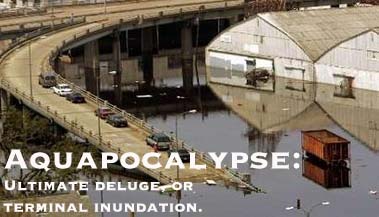 Sunken City – July 2007
Sunken City – July 2007
When Lake Falcon’s water level drops, ghost towns emerge from the depths.
By E. Dan Klepper
Arturo the gatekeeper steps from the shadow of his sandstone dwelling into the light of the early afternoon. His simple abode, a blade-sharp rectangle of rocks, lies along the boulevard of a Mexican city built more than two and a half centuries ago. A coyote skull rests on one of the building’s cornerstones. Arturo’s dog, rousted from her nap by the arrival of visitors, appears at the edge of the Tamaulipan thornscrub, then waits patiently for a friendly sign before approaching. She is shy or cautious, one healthy brown eye avoiding the visitors’s gazes, one failing blue eye ticking hard like a ricocheting marble.
The surrounding countryside is radiant with spring flowers and berries. Scores of blackbrush have gone lemon-white with blooms. Their scent permeates the air in a musk more savory than sweet, a smell that attracts and repels all at once. Ruby berries of tasajillo droop from sticky branches like fly-blown orchard fruit. The ground around them is covered with verbena.
<snip>
A scan of the area reveals a landscape equally at odds with the routine world; an empty parakeet cage and a deer hoof hang together from a nearby branch, javelina skulls tuck into tree forks, snake skins dry in the sun, and tidy assemblages of rubber and tin teeter in cartoon-like pillars. But most surreal are the myriad stone facades lining the boulevard and the intersecting avenues that cross-hatch the horizon. As far as the eye can see, architecture collapses in heaps of square-cut blocks, barrel segments of stone-carved pillars, and remnants of lintels, pediments, keystones and voussoirs. Other structures stand erect and intact, some with rusticated walls beneath peeling stucco, others with prickly pear cactus growing from their cornices. Homes, shops, cemeteries, plazas and a cathedral all sprout from the thick vegetation, Pompeii-like, in a visage of ruin. But it wasn’t a natural disaster that reduced this 250-year-old community in the Mexican state of Tamaulipas to a surrealist’s rubble. It was, instead, the construction of Falcon Dam and a slowly rising tide of water.
Devised and built jointly by the United States and Mexico pursuant to the Water Treaty of 1944, the International Falcon Dam and Reservoir project was put in place to provide flood control, water conservation and hydroelectric power to communities on both sides of the lower Rio Grande. The rolled, earth-fill embankment dam, with its maximum base-width of 1,000 feet and a height of 150 feet above the river bed, was designed to hold back more than 2 million acre-feet of water. But in doing so, almost 115,000 acres of the Texas and Tamaulipas landscape were submerged. Shortly after the completion of the dam, reservoir waters inundated ranches, farms, riparian habitat, rural homes and, in fact, entire towns on both sides of the border. The original Texas communities of Zapata, Falcon and Lopeño went under as well as much of Arturo’s charge — the beautiful Spanish colonial town now called Old Guerrero.
Arturo invites the visitors into his unlit dwelling where the sun shines as mid-day shafts through cracks in the windows’ wooden shutters. Twilight illuminates the rusting works of a kerosene lantern and the shed skin of an indigo snake that hang together on a nail. Pieces of a wooden wagon lay across the floor. The abode is part residence for Arturo and his animal menagerie and part showcase for fading newspaper clippings and graying photocopies that tell the story of Guerrero’s watery decline.
Established in 1750, Guerrero was once a vibrant urban center of trade with more than 25,000 citizens. The town, originally named Villa del Señor San Ygnacio de Loyola de Revilla and built near the Rio Grande at the mouth of the Salado River, was renowned for its Spanish Colonial art, enterprise and architecture. In fact, Guerrero was considered a key link in the compelling history of the entire Lower Rio Grande Valley due to its location, age and considerable beauty.
<snip>
Arturo disappears behind a blanket-hung doorway and retrieves a stack of dog-eared papers. He returns and shuffles through the archive of photocopies and articles that document bits of Guerrero’s history and its ultimate demise, pausing occasionally at the visitors’ request. The images of Guerrero’s classic cathedral, Nuestra Señora del Refugio, submerged halfway up her portico arches and relegated to a slow deterioration are painful to view.
<snip>
The cycle of inundating floods and crop-killing drought was the bane of farmers, ranchers and the myriad communities along the Lower Rio Grande Valley throughout the 19th and first half of the 20th centuries. The creation of the International Falcon Dam and Reservoir was, by federal declaration, the solution. Construction was completed just in time, in fact, to arrest the damaging waters of the historic flood of 1954. According to a report published in the San Antonio Express on July 1, 1954:
<snip>
Directions to Old Guerrero
(Antigua Guerrero Viejo)Round-trip distance is approximately 60 miles from Falcon State Park into Mexico and back. A high-clearance, 4-wheel-drive vehicle is recommended.
The ruins are extensive. Hiking boots, water, food, cameras and binoculars are recommended. Watch for venomous snakes. Mountain bikes are welcome. A small fee is required to view the ruins.
Be sure to check on the latest identification requirements for crossing the U.S. border into Mexico and back via automobile. A fee may be required from the Mexican checkpoint for re-entry. U.S. dollars are accepted.
The route is relatively simple whether you are traveling south from Zapata or north from Rio Grande City via Highway 83. Turn onto FM 2098 (a sign for Falcon State Park points the way). Continue on FM 2098 past Park Road 46 (which will take you to Falcon State Park) until you reach Falcon Dam. Bypass the U.S. border checkpoint station and continue driving along the dam, where you will cross the international border between the U.S. and Mexico. Slow down at the Mexican border checkpoint station, where you may or may not be asked to stop. Once through the checkpoint, you will be traveling on Blas De La Garza Falcon. Continue on Blas De La Garza Falcon into the small town of Nueva Ciudad Guerrero (New Guerrero). Continue to the Avenida Miguel Hildago Y Costilla intersection. Turn left onto Avenida Miguel Hidalgo Y Costilla and continue a short distance to Highway 2 (the Nuevo Laredo–Mier Highway). Turn right (west) onto Highway 2 and continue for approximately 21 miles. After crossing Puente Rio Salado (the Salado River Bridge) continue another 3.2 miles and then look for a blue sign indicating the road to Antigua Guerrero Viejo. Turn right. Follow the rough (and often muddy) unpaved ranch road approximately 10 miles. Additional blue signs for Antigua Guerrero Viejo have been posted on the route. You will pass through a number of ranch gates along the way (approximately eight — most with cattle guards). Please leave gates as you find them. Also, be aware that these gates are locked by 6 p.m. The road terminates at Antigua Guerrero Viejo and the shores of Falcon Reservoir.
Read entire article here: www.tpwmagazine.com/archive/2007/jul/ed_6/


 TalkStreamLive.com
TalkStreamLive.com














































